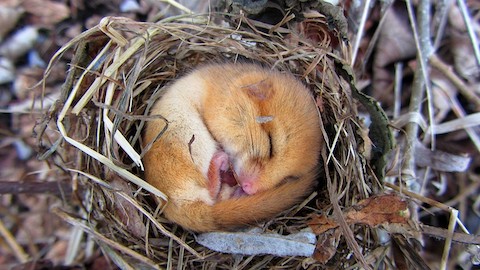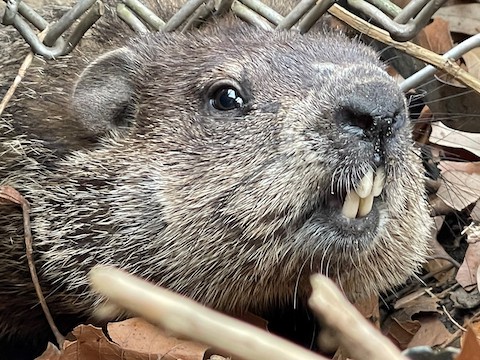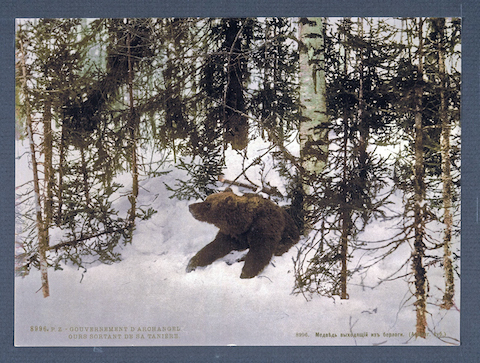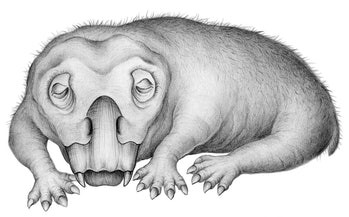
Credit: Zoë Helene Kindermann, via Wikimedia Commons
When conditions turn extreme and food and water get scarce, many creatures shut down their metabolism and go into suspended animation.
This is much different than sleep. Body temperature drops to near the ambient temperature. Bodily functions slow, with some stopping altogether.
This dormancy comes in several varieties:
Some species go into daily torpor in the heat of the day. Hummingbirds, for instance, will find a shady place to shut down, and drop their heart rate to just 5% of normal.
Depending on the severity of winter, bears, skunks and other light hibernators will reduce their heart rate to around 50% and become dormant for a few days to a few months.
So they can wake more easily to respond to danger, they remain somewhat responsive to outside stimuli.
True hibernators are usually small species weighing just a few ounces, like the dormouse.
In years when food is scarce, they’ll put on as much fat as possible, skip reproduction and hibernate till next year brings a better crop of seeds.
Many water and desert species enter what’s called estivation, brought on by drought or heat. Some fish burrow into the mud till the rains return. Snails may seal themselves in their shells for up to a year.
Dormancy of all kinds helps animals conserve energy and hide from predators—and many species of mammal, bird, reptile and insect have been doing it for more than 250 million years.
Background
Synopsis: Each winter, when conditions are extreme and food sources are limited, certain animals stay alive by entering states of dormancy that drastically reduce their bodily functions. It is called hibernation if it lasts for weeks or months and daily torpor if it lasts for less than 24 hours. This inactivity has served as a survival tactic for at least 250 million years and is employed by a wide variety of mammals, birds, insects, reptiles and amphibians. When animals use this tactic to survive a hot summer drought, it is called estivation.
- The three states of torpor—hibernation, estivation and daily torpor—occur as a means of energy conservation during extreme conditions of temperature or food scarcity. These three states are not the same as a deep sleep but are more like suspended animation.
- When animals sleep, their unconscious physiological functions continue with body temperature, respiration, heart and metabolic rates remaining within normal ranges.
- These three states of dormancy differ dramatically from sleep, as body temperature approaches ambient temperature and most physiological functions decline to around 5% of normal with some ceasing altogether.
- Long dormancy in winter is called hibernation, while drought conditions trigger estivation. Food shortages and cold cause may cause bouts of daily torpor in some species.
- An added benefit of torpor is protection from predators, as the lack of noise, movement and scent makes dormant animals difficult to detect.
- True hibernation is a voluntary state that certain animals, including deer mice, ground squirrels, woodchucks, snakes, bees and some bats enlist for weeks or months to conserve energy through the winter.
- Most mammalian hibernators are small, averaging less than 2.5 oz (70 g). It is easier for small animals to hibernate than to migrate long distances to escape the cold.
- Hibernators store energy-rich brown fat in the summer and fall to help them survive the winter season.
- Dwindling food supply and shorter days lead to hormonal changes that cue the hibernators to find a long-term hideaway and settle in. During winter, hibernator blood has been found to carry a substance that keeps them hibernating and can initiate hibernation in active animals, even in summer.
- True hibernators briefly wake a number of times during hibernation, expending energy to warm themselves, eat, expel waste, restart their immune systems and to get some normal sleep.
- Full arousal at the end of the hibernation period takes hours as the hibernator’s bodily functions reactivate with intense muscle contractions, using up much of their remaining fat reserves.

Credit: Mousebelt, via Wikimedia Commons
- True hibernation is akin to suspended animation.
- The heart rate of a woodchuck drops from 80 beats per minute when active to just 5 beats per minute when hibernating. Its body temperature drops from 98oF (37oC) to 38oF (3oC). When active, its incisors grow continuously and are worn down by gnawing, but while hibernating, they stop growing, leaving an annual record, like tree rings.
- When Madagascar’s dwarf lemurs hibernate during winter, they access fat stored in their tails. The tiny primate’s heart rate drops from 300 to about 6 beats per minute, and they can go 10 minutes without taking a breath. Captive bred lemurs also hibernate, showing that the behavior is built into their DNA.
- The record for longest mammal hibernator goes to the edible dormouse (Glis glis). In years of low abundance of the beech seed they feed on, they fatten up as best they can, skip reproduction and hunker down for 8 to 11 months. Ancient Romans considered the chubby, hibernation-ready dormice a delicacy, resulting in their common name.
- The celebration of Groundhog Day got its start when people noticed hibernating groundhogs check for spring conditions before emerging from their dens.
- Cold-blooded hibernators like snakes, turtles and frogs protect themselves from freezing by burying themselves in the mud below the frost line and breathing soil oxygen.

Credit: Photochrom Print Collection, via Wikimedia Commons
- Light hibernation is involuntary and is controlled by external conditions.
- Bears, raccoons and skunks are all light hibernators.
- Their systems force them into variably long periods of torpor on and off all winter as dictated by temperature and food availability.
- Bears drop their metabolic rate by about 50% and can hibernate for 100 days straight without waking, maintaining a body temperature just 12oF (7oC) lower than normal, so they can react quickly to danger. They are much easier to rouse than true hibernators are.
- Each year bears hibernate for a few days or weeks in Mexico, while bears in Yellowstone National Park and Alaska hibernate for 5 to 6 months.
- Daily torpor is used by some animals to conserve energy on a daily basis, especially when food is scarce.
- Some hummingbirds enter torpor each day to conserve energy, reducing their heart rate from 1200 to 50 beats per minute.
- Estivation occurs for long durations in response to conditions of extreme heat or drought.
- During dry periods, the West African lungfish forms a protective cocoon of mucus then burrows into the mud to wait for rain.
- Snails seal the entrance to their shells with mucous to prevent desiccation and may not emerge for more than a year.
- Australian echidnas estivate after wildfires, awaiting recovery of their food sources.
- Other animals that estivate include mollusks, crabs, crocodiles, some salamanders, mosquitos, desert tortoises and some hedgehogs.

Credit: Crystal Soojeong Shin, Christian A. Sidor, Megan Whitney with permission
- Recent studies have shown that animals have been hibernating for a very long time.
- A 250-million-year-old pig-sized therapsid (mammal ancestor) called Lystrosaurus had continuously growing tusks that recorded fast and slow growth through time, like tree rings.
- Cross sections of tusks with annual growth rings from 6 Antarctic Lystrosaurus fossils showed periods of lower growth than tusks from 4 similarly aged South African Lystrosaurus fossils, indicating possible longer torpor periods for the Antarctic animals.
- It also suggests the animals may have been warm-blooded since they showed increased stress in the colder Antarctic environments.
- Studies of 430,000-year-old hominin skeletons from Spain’s Sima de los Huesos cave suggest these ancient human ancestors may have been trying to sleep through winter.
- Evidence of vitamin D deficiencies, loss of bone mass with tumor development and odd annual sporadic growth spurts in the bones of teenagers suggest attempts at sleeping through colder months without sufficient fat stores, but studies are still underway.
- Scientists are interested in animal hibernation for purposes of future space travel and for fighting diseases like cancer in humans.

